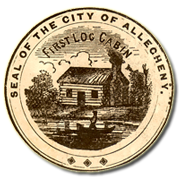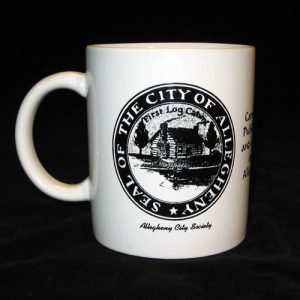Allegheny Unitarian Universalist Church is one of a few Allegheny congregations that has both reached the century mark and continued to serve the community from its original building. The 100th anniversary of the dedication of the congregation’s historic church building occurred on February 6, 2010.
The story of how the congregation’s “common home and fireside” came to be begins with English-born Congregationalist minister, Thomas Clayton. Reverend Clayton arrived in Allegheny City to take up the pastorate of the First (Pilgrim) Congregational Church of Allegheny on August 4, 1901. That church was located at the southeast corner of Manhattan and Franklin Streets in the Manchester district.
Thomas Clayton was born in London in 1854. He attended Wesleyan College and Richmond College Seminary where he studied for the Methodist Episcopal ministry. Shortly after completing his studies in 1885, Mr. Clayton came to the United States. He was ordained a minister in September of that year by the Methodist Episcopal Conference in Berea, Ohio, but resigned in 1886 to enter the Congregational ministry. He served several Congregational churches in the Northeast before accepting the call to First Congregational Church in Allegheny.
By the winter of 1904, after eighteen years in Congregational ministry, Rev. Clayton’s theological views had modified to the extent that he decided to seek ministerial fellowship with the American Unitarian Association. So, in the spring of 1904, Rev. Clayton began correspondence with the Unitarians. The First Congregational Church released him from his pastorate in March, and he submitted an application for fellowship in April. Rev. Clayton also began talking with Rev. L. Walter Mason, minister at Pittsburgh’s First Unitarian Church in Shadyside.
Rev. Clayton preached at First Unitarian in May, and made a favorable impression—even though it was observed by Rev. Mason that he retained “the tenderness…of the old faith” for the Bible. His application for fellowship was approved in June by the Middle States Committee to take full effect six months later in accordance with the vote of the National Conference (from a notice in the Unitarian journal, the Christian Register, June 23, 1904). Rather than seek a pulpit elsewhere, Reverend Clayton decided to stay in Allegheny. He obtained a position in a local business to support his family, but he clearly intended to return to the work of ministry.
In 1905, Rev. Clayton began the planning necessary to organize a Unitarian society in Allegheny City. Working with Rev. Mason, a first meeting was arranged for the evening of Sunday, December 5. A group of Allegheny residents sympathetic to liberal religion was invited and they were joined by Rev. Mason and members of the First Church congregation. The meeting was held in Allegheny’s Carnegie Hall on East Ohio Street. At that first gathering, tentative plans were discussed, several names were added to a covenant book and services were scheduled for subsequent Sunday evenings.
At the meeting on January 21, 1906, the group formed a temporary organization to comply with an Allegheny City ordinance requiring that the auditorium be rented only to organized religious bodies. Reverend Clayton was appointed Treasurer, and Elizabeth Hampson, M.D., Secretary. The name Second Unitarian Church was chosen. The meeting was continued three days later at Dr. Hampson’s residence on Monterey Street, where a temporary Board of Trustees was elected, including Dr. Robert H. Gilliford as President.
Dr. Gilliford was born in Fawn Township, Pennsylvania, and came to Allegheny City to set up his practice in 1874 after receiving his degree from the Medical College at Charleston, South Carolina. For seven years he was on the surgical staff at Allegheny General Hospital, and for three years was the Poor Physician for the western district of Allegheny City. Dr. Gilliford served as a member of the Common Council from the Sixth Ward for two years, and was a member of the Select Council from the same ward for nine years. During his time in government he enjoyed a great reputation as a municipal reformer, and was a prominent figure in local politics.
On May 6, 1906, Dr. Gilliford called the meeting of the Second Unitarian Church to order and Rev. Charles E. St. John, Secretary of the American Unitarian Association, made a brief address in which he assured the group that the AUA and its officers would support their efforts. A motion was made by Rev. Clayton and seconded by founding member, W. R. Negley, to make the temporary organization “regular and permanent.” Forty-three charter members were enrolled.
The Sunday evening Services continued to be held in the Carnegie Hall, with members of the First Unitarian Church attending and lending their support—and their organist. Postcards featuring a photograph of the hall and a list of upcoming services were distributed to promote the newly formed congregation. Carnegie Music Hall, though, could not serve the congregation indefinitely, so in December 1906 a lot was secured at the corner of West North Avenue and Resaca Street for the purpose of erecting a church building. Dr. Gilliford paid $10,000 for this desirable lot fronting the Commons, agreeing to hold it until the congregation could raise funds to purchase it from him.
In the spring of 1907, the congregation incorporated in the Commonwealth as the North Side Unitarian Church, and secured the services of architect Robert Maurice Trimble. For Trimble, whose family was active in Allegheny City politics and business, this would be the first of a series of important local commissions.
Robert Maurice Trimble was born in the Sixth Ward of Allegheny City in 1871, son of businessman John H. Trimble (1841–1908). The Trimble ancestors had originally settled in Butler County but moved to Allegheny City shortly before the Civil War. John Trimble helped found the family construction business. He also served for 17 years on the school board for the Sixth Ward, and later represented the Ward for ten years on Allegheny City Council.
R. Maurice Trimble graduated from Allegheny High School in 1887, and studied at the Western University of Pennsylvania in 1888. He then associated with his father in the general contracting business until 1892, when he began the study of architecture with Frederick J. Osterling. He worked with Osterling as a draughtsman until 1898, when he opened his own architectural office. Trimble’s one previous church commission, St. Thomas Episcopal Church (Oakmont), was a study in the west-tower form of the English parish church. For the North Side Unitarian Church Trimble again drew upon late medieval precedents, but developed an architectural expression appropriate for its time and place. The drawings were presented to, and approved by the congregation in September 1907. Dr. William Judson Riggs, Trustee, worked over the next two years to promote the new church building.
William J. Riggs was born in 1849 in Library, Pennsylvania, the son of Rev. Edward Riggs. He attended Jefferson Medical College in Philadelphia and returned to practice medicine with his older brother, David, in Allegheny City. The brothers were well liked by the people of Allegheny, and when David retired, the younger Dr. Riggs continued their practice. At the congregation’s Annual Meeting in March 1909, the “New Church” project was discussed, the “blueprints” displayed, and an appeal made by Reverend Clayton for contributions to the building fund. Dr. Riggs stated that the construction contract would be “let out” about the first of July. Unfortunately, Dr. Riggs died on May 31, 1909 within days of his older brother David and never saw the church building that he helped to make a reality. Dr. Riggs’ family presented the window on the west side of the sanctuary as a memorial to him.
The congregation was able to purchase the lot from Dr. Gilliford for $10,500. Ground was broken for the new church on July 8, 1909. The building permit, issued in Pittsburgh (Allegheny City having been annexed), was recorded July 22nd. The permit indicated that there would be built a stone church with slate roof, sized 41 feet wide by 73 feet deep, one story in height, J. M. Poorbaugh as builder, and all at a cost of $15,000 (bringing the total, with property, to $25,500).
The Services dedicating the new church building took place on a cold Sunday, February 6, 1910. The dedication included these words: “May it be our common home and fireside, ministering to all our higher needs…” The guest speakers at the Services included Rev. F. A. Tischer of Homestead; Rev. George H. Badger, Secretary of the American Unitarian Association; Rev. Mason of First Church; Rev. F.C. Southworth, President of Meadville Theological School (Unitarian) and Rev. Albert C. Dieffenbach of the North Side’s Church of the Ascension (Reformed) representing the liberal churches of Pittsburgh.
Albert Charles Dieffenbach came from a long line of Reformed Church (German) clergymen. He studied at the Theological Seminary of the Reformed Church in Lancaster. In October 1901, he was ordained by the Allegheny Classis. As a field missionary for the Sunday School Board he helped found Allegheny’s Reformed Church of the Ascension in September 1902, and in November 1903 a cornerstone was laid for a church building on Termon Avenue. Rev. Dieffenbach was known for his liberal religious views, and in 1911 both he and Pittsburgh colleague Rev. John H. Dietrich transferred to the Unitarian ministry. Dieffenbach and Dietrich became national figures and were among the contributors and signers of the Humanist Manifesto I in 1933. Rev. Dieffenbach also served as editor of the Christian Register.
The North Side Unitarian Church building was not completely finished by the time of the dedication in February 1910. Oral history tells of one founding member’s children bringing food from their house on Pennsylvania Avenue in pull wagons for a church dinner because the lower-level kitchen was not complete.
Within days of the building dedication, Rev. Clayton tendered his resignation, evidently feeling that this phase of his work was complete. During the time that the church sought a new minister, church organizations did much to keep the congregation vital. The newly formed Women’s Alliance engaged in active fund raising, including bake sales in the Allegheny Market House at Federal and Ohio Streets. By year’s end, Reverend Charles E. Snyder was called to be minister, and was installed in January 1911, initiating a period of growth that would often see the new sanctuary packed to the doors.
Over the course of the last one hundred years, the church has continued to be well used—not only for services of religion, but also for community service. It has always been the congregation’s belief that they are stewards of a sacred space that is common home and fireside for all of their North Side neighbors. May it continue to be so for another one hundred years!





